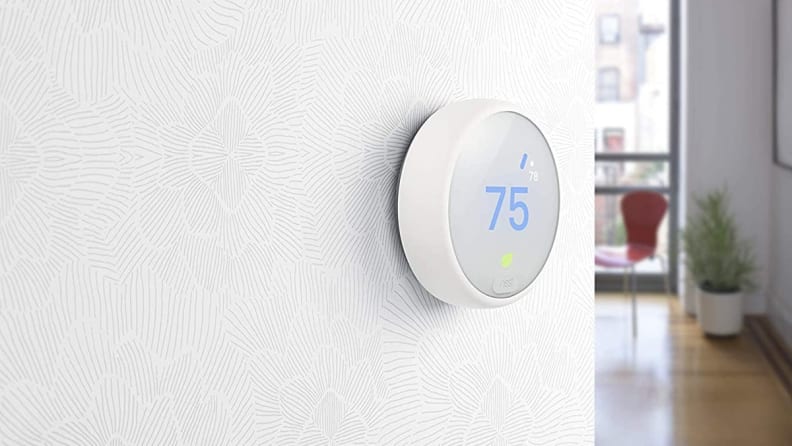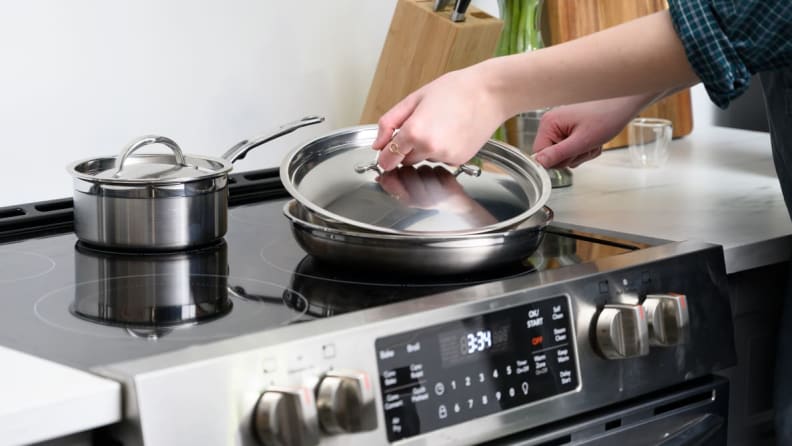Products are chosen independently by our editors. Purchases made through our links may earn us a commission.
On average, American households spend about $3,039 a year on energy bills, according to Move.org. And if you’re working from home right now, you've likely seen those costs spike.
With keeping the lights on, running the AC or heat all day, and taking more trips to the bathroom between Zoom calls, it all adds up.
Fortunately, there are plenty of small ways to keep your utility bills in check. And as a bonus, these tricks help you save on energy costs, too.
If you’re looking to trim your gas, water, and electric bills, here are 10 ways to start.
1. Install a smart thermostat

This smart thermostat automatically adjusts the temperature to lower your energy bills.
Swapping out your old thermostat for a smart version is the easiest way to make your home’s HVAC unit more efficient, says Clint Robertson, home improvement expert and American Standard® Heating & Air Conditioning partner.
This change can help you shave as much as 10% to 12% off your heating bills, and up to 15% on cooling. If you’re in the market for one, one of our favorite smart thermostats costs $130.
Even if you’re not shopping around, your current one is most likely a programmable thermostat and you should look at the settings if you haven’t already.
2. Seal and insulate your home
About 20% of the air moving through your home is lost to air leaks and poor insulation. That leakage can raise your heating and cooling bills and make your home less comfortable.
Weatherizing your home, which involves sealing and insulating, can help plug the leaks and save 10% on your energy bill every year, according to EnergyStar.
The government-affiliated agency says you should first identify leaks in the attic and basement, where the air most commonly escapes. Throughout the house, install weather stripping around doors and windows, and fit caulking around outlets and pipes to further lower utility costs.
3. Reduce humidity

Cover your pots and pans while cooking to limit the humidity in your home.
While humidity can make any outdoor activity unpleasant, it also wreaks havoc inside the home.
“A humid house will make the air conditioning work harder and won’t be easy on the utility bill,” Roberston, who's also a co-host of HGTV show Boise Boys, says. Plus, humidity promotes rot and mold—which leads to poor air quality, unsightly stains, and bad odors.
Robertson recommends keeping your house at 30%–50% humidity with these few steps:
- Take shorter showers with cooler water. (One of these bathroom gadgets helps you control the temperature.)
- Cover pots and pans while cooking.
- Use dehumidifiers, which cost less than cooling the house.
We’ve tried out a bunch of dehumidifiers, and our favorite, the LG Puricare, reduced the amount of humidity by nearly 50% in about an hour and a half during our lab tests. At under $300, it’s easy to move and store, plus it also uses the least amount of energy of all the similar models we looked at.
4. Replace air conditioning filters
Regularly changing your air filters every 30 to 90 days “helps your HVAC operate properly rather than work overtime,” Robertson says. He recommends the American Standard QuikBox Filter Rack.
The advice applies for portable AC units, too. Replace these filters at least every three months for max efficiency, money savings, and improved air quality.
5. Close the blinds
About three-quarters of the sunlight coming through your windows is transferred into heat, which can make your air conditioning work harder in the summer. But Robertson says one simple trick to save on utilities can help you beat the heat.
“Closing windows, drapes, and blinds during the day—and opening them again when the sun goes down—is an easy and affordable way to help keep the house cool at all times,” he says.
You can even take it a step further with smart blinds, which are motorized shades that automatically adjust and can open and close on a set schedule.
6. Get an HVAC tuneup
EnergyStar suggests hiring a contractor once a year to service your HVAC system. The tuneup can cost up to $450, but it's worth the price tag because it helps the HVAC system run efficiently and keep utility bills in check. It can also lengthen the life of your HVAC, which costs about $5,500 to replace.
But, “if the system is more than 10 years old, consider what you'd save in a full replacement,” Robertson says. Repairing your air conditioning system, for example, could cost up to $1,500. Meanwhile, a new, energy-efficient HVAC system can help lower your energy bills and provide better air flow.
7. Swap out your light bulbs
Switching to energy-efficient light bulbs is one of the easiest ways to cut your energy bills. Although halogen incandescent, CFL, and LED light bulbs cost a bit more upfront, they help you save money in the long run because they use less energy compared to traditional incandescent bulbs.
Shop for these light bulbs with the EnergyStar label, and you can save $45 each year. We’ve ranked our favorite smart light bulbs, with this Philips Hue starter kit coming in at number one because of its uncomplicated setup and easy-to-use app.
8. Check for state programs
Plenty of state and local programs offer money-saving incentives and ways to make your home more energy-efficient. To check out initiatives near you, head to the Database of State Incentives for Renewables & Efficiency and plug in your ZIP code. Depending on your location, you may find tax credits, grants that don’t need to be repaid, loan programs, and energy audits.
In Massachusetts, for example, the Mass Save program connects homeowners with energy experts who visit your home and identify ways you can save energy. They also give you free stuff like energy-efficient light bulbs, power strips, and showerheads.
9. Save water
Conserving your water usage can help cut down your water bill and preserve the natural resource. Here are some simple ways to save:
- Turn off the tap when you scrub your hands, brush your teeth, and shave.
- Limit your showers to five minutes or less.
- Install water-saving showerheads or devices that restrict flow.
- Repair leaky faucets and pipes.
- In the yard, position your sprinklers so they’re only watering the plants and grass.
- Consider getting a rain barrel.
10. Look for the EnergyStar label
EnergyStar is a labeling program developed by the U.S. Department of Energy and the Environmental Protection Agency (EPA). To qualify for the label, appliances must meet or exceed minimum efficiency ratings.
Look for the designation on everything from kitchen appliances to water heaters and pool pumps. The label includes an annual cost-of-use estimation, which can help you budget realistically, keep your utility bills down, and reduce your energy use.
Washers and dryers, for example, are one of the biggest energy suckers in our homes. Our favorite set from Electrolux, with a designated spot for detergent pods to help evenly distribute soap, meets the EnergyStar standards.
Other Articles You Might Enjoy
- The Best Dryer Balls
- The Best Smart Plugs
- Why cold water washing is the future of laundry
- 8 personal finance apps that put cash back in your pocket
The product experts at Reviewed have all your shopping needs covered. Follow Reviewed on Facebook, Twitter, and Instagram for the latest deals, product reviews, and more.


